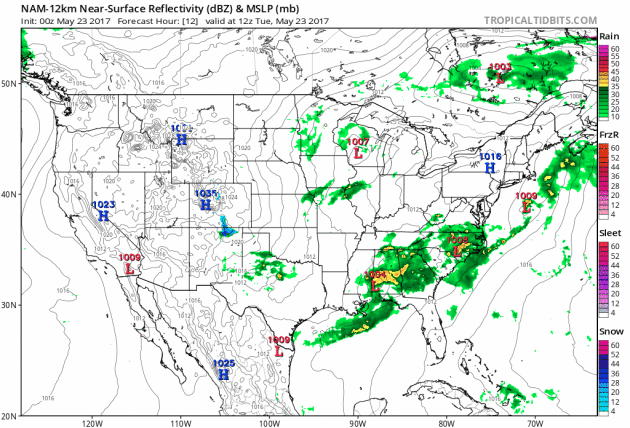62 F. high in St. Cloud on Monday.
71 F. average high on May 22.
84 F. high on May 22, 2016.
May 23, 1914: An early heat wave hits the state, with a high of 103 at Tracy.
Downtown Tornadoes - Real Summer Heat On The Way
I spend a little time every day trying to clear up weather myths and meteorological misunderstandings. People love to explain to me how living in a downtown leaves them immune to tornadoes. Wrong.
Tornadoes feed on warm moist air and twisting winds within a 10-20 mile radius. A few high rise buildings and some concrete won't deter them from forming. Twisters have touched down in major cities from Chicago and Dallas to Salt Lake City. Oklahoma City has been hit over 140 times since 1890.
On May 22, 2011 a powerful tornado with winds up to 110 mph tracked 14 miles into North Minneapolis; the funnel nearly half a mile wide at one point.
Models strongly suggest a summer-like pattern by early June with 80s, high dew points and a wind field more favorable for severe T-storms. We're due.
Instability showers linger today, but our weather improves on Wednesday. Friday looks like the warmest day; the best chance of a shower comes Sunday. Memorial Day may be dry, with some sun and 60s.
May has set two records for daily rainfall at MSP. 4.75" has fallen; twice the normal amount.
Thumbnails above courtesy of the Twin Cities National Weather Service, which has more information on the May 22, 2011 North Minneapolis tornado here.

Did Someone Predict the Recent Wisconsin Tornado? Meteorologists can tell when atmospheric conditions are ripe for tornadic storms, but we still can't pin down where individual thunderstorms will spin up funnels more than 20-30 minutes in advance. Here's an excerpt from Madison.com: "We cannot yet forecast tornado occurrence with any accuracy. One problem is the small size of a tornado, which is a narrow column of strong winds that rotate around a center of low pressure. Over the last 60 years, forecasts of the development of large-scale low-pressure systems, which often organize the ingredients needed to form a tornado, have steadily improved. Because of these advances, meteorologists are better able to predict those conditions a few days in advance, enabling forecasters to identify counties where there is a threat of severe weather sometimes as many as three days in advance. Two days in advance of the recent EF-2 tornado that hit southeastern Polk County, the National Weather Service’s Storm Prediction Center’s convective outlook issued a slight-risk for the area..."
Remembering Joplin. The wedge tornado that struck Joplin, Missouri on May 22, 2011 was a reminder of the limitations of technology. Here are a few of the take-aways from NOAA: "...This was the single deadliest tornado in U.S. history since modern record-keeping began in 1950. Rated EF-5 on the Enhanced Fujita scale, this mile-wide tornado was the largest and most powerful type, and it traveled 22 miles on the ground. The report includes a number of key recommendations:
- Improve warning communications to convey a sense of urgency for extreme events. This will compel people to take immediate life-saving action;
- Collaborate with partners who communicate weather warnings to develop GPS-based warning communications, including the use of text messaging, smart phone apps, mobile communications technologies, in addition to upgrades to the Emergency Alert System and NOAA Weather Radio;
- Collaborate more throughout the weather enterprise to ensure that weather warning messages sent via television, radio, NOAA Weather Radio, local warning systems such as sirens – are consistent to reduce confusion and stress the seriousness of the threat; and
- Continue to increase community preparedness..."
Image credit: "Radar image showing the tornado as it exits Joplin. A debris ball is present in the top left corner image in pink. Radar image was taken around 7pm ET."
Number of People Affected by Weather-Related Disasters: 1995-2015. Flooding is, by far, the most prevalent meteorological disruptor across the planet.
Image credit: UNISDR / CRED.Photo credit: "Some oil companies are talking publicly about peak oil demand and preparing for it by overhauling their long-term investment plans." Andrey Rudakov/Bloomberg News
Solar Employs More U.S. Workers Than Apple, Google and Facebook Combined. With a little perspective on renewables and employment here's a clip from ThinkProgress: "...As
of 2016, California has just over 100,000 solar jobs — a one-third
increase over the previous year. The country added a record 50,000 solar jobs last year. The U.S. solar industry currently has more than 260,000 workers nationwide, according to The Solar Foundation. Their executive director, Andrea Luecke, points out
that’s more workers than “Apple, Google, Facebook and Amazon combined.”
(As a point of clarification, Amazon has added jobs at a torrid pace in
the last couple of years, so the 260,000 solar jobs is ‘only’ more than
Apple, Google, and Facebook combined.)..."
Photo credit: "A rooftop is covered with solar panels at the Brooklyn Navy Yard, February 2017." CREDIT: AP/Mark Lennihan.
Photo credit: Bloomberg and Azuri Technologies.
How AI Is Changing Your Job Hunt. Here's a snippet of an interesting story at Fortune: "...It
isn’t just startups using such software; corporate behemoths are
implementing it too. Artificial intelligence has come to
hiring.Predictive algorithms and machine learning are fast emerging as
tools to identify the best candidates. Companies are using AI to assess
human qualities, drawing on research to analyze everything from word
choice and microgestures to psycho-emotional traits and the tone of
social media posts. The software tends to be used in the earlier part of
the process, when companies are narrowing a pool of applicants, rather
than in the later stages, when employers place a premium on face-to-face
interaction and human judgment..."
Photo credit: Ian Allen.
"Avolatte": Hipster Cafes Serve Lattes in Avocados. It's official, we've run out of good ideas. The Independent explains why anyone would want to drink fancy coffee out of an avocado: "...Just
why anyone would want to drink a latte from an avocado over a regular
cup is unclear - would the coffee be infused with avocado? How would you
hold it without a handle? Is it to save on washing up? What with
avocados and latte art both amongst millennials’ favourite Instagram
subjects, it’s possible the avolatte could be the next big trend fuelled
by the picture-sharing social network..."
Image credit: "The avolatte." / Instagram/tom.inc.
TODAY: Cool and showery. Winds: N 7-12. High: 59
TUESDAY NIGHT: More light showers. Low: 45
WEDNESDAY: Partly sunny and pleasant. Winds: NE 7-12. High: 63
THURSDAY: Fading sun, slight T-shower risk late. Winds: SE 8-13. Wake-up: 48. High: 73
FRIDAY: Lukewarm sun, stray T-storm. Winds: S 10-15. Wake-up: 55. High: 78
SATURDAY: Partly sunny, not bad for a weekend. Winds: NW 8-13. Wake-up: 58. High: 72
SUNDAY: Unsettled, few showers possible. Winds: NW 10-20. Wake-up: 53. High: 68
MEMORIAL DAY: Mix of clouds & sunshine, breezy. Winds: NW 10-20. Wake-up: 51. High: 67
WEDNESDAY: Partly sunny and pleasant. Winds: NE 7-12. High: 63
THURSDAY: Fading sun, slight T-shower risk late. Winds: SE 8-13. Wake-up: 48. High: 73
FRIDAY: Lukewarm sun, stray T-storm. Winds: S 10-15. Wake-up: 55. High: 78
SATURDAY: Partly sunny, not bad for a weekend. Winds: NW 8-13. Wake-up: 58. High: 72
SUNDAY: Unsettled, few showers possible. Winds: NW 10-20. Wake-up: 53. High: 68
MEMORIAL DAY: Mix of clouds & sunshine, breezy. Winds: NW 10-20. Wake-up: 51. High: 67
Climate Stories...

A Conservative Answer on Climate Change. Here's an excerpt of an Op-Ed at The Pittsburgh Post-Gazette: "...Our conservative plan would attack pollution the way that Milton Friedman, a captain of modern conservatism, told us to attack it years ago: Tax it. A carbon tax would attach the cost of pollution to products so that the marketplace could see and rightly judge all of the costs of those products — the costs that the producer’s marketing department would let us see and the costs that they’d rather secretly slough off to the suckers who have to breathe their soot. If those costs were internalized on a level playing field, unsubsidized clean energy would beat unsubsidized dirty energy. Under this plan, all the carbon tax money would go back to taxpayers through offsetting, dollar-for-dollar cuts to existing taxes or through dividend checks. There would be no growth of government..." (File image: Star Tribune).

Arctic Security Poses Icy Chess Game with Russia, China. Here's an excerpt from TheHill: "...The promise of resource exploitation has already motivated Russia and, in some instances other countries, to assert greater territorial rights, enhance Arctic military capabilities and make investments to facilitate commercial activity. Unfortunately, the United States has remained a relative bystander to this expanding Arctic activity. With the disappearance of the snow and ice, the region is at risk of veering from its history of cooperation. A Department of Defense report issued in December 2016 predicted that “competition for economic advantage and a desire to exert influence over an area of increasing geostrategic importance could lead to increased tension.” In what may be a prelude, the region is already witnessing increased shows of Russian military might..."
File photo credit: US Army National Guard, Staff Sgt Balinda O 'Neal Dresel.
Photo credit: "Warmer temperatures don't always mean doom and gloom when it comes to farming in the Treasure Valley." (Photo: Mike di Donato/KTVB).
Scientists Say the Pace of Sea Level Rise Has Nearly Tripled Since 1990. Chris Mooney reports for The Washington Post: "A new scientific analysis finds that the Earth’s oceans are rising nearly three times as rapidly as they were throughout most of the 20th century, one of the strongest indications yet that a much feared trend of not just sea level rise, but its acceleration, is now underway. “We have a much stronger acceleration in sea level rise than formerly thought,” said Sönke Dangendorf, a researcher with the University of Siegen in Germany who led the study along with scientists at institutions in Spain, France, Norway and the Netherlands. Their paper, just out in the Proceedings of the National Academy of Sciences, isn’t the first to find that the rate of rising seas is itself increasing — but it finds a bigger rate of increase than in past studies. The new paper concludes that before 1990, oceans were rising at about 1.1 millimeters per year, or just 0.43 inches per decade. From 1993 through 2012, though, it finds that they rose at 3.1 millimeters per year, or 1.22 inches per decade..."
File photo: Skeptical Science.
Photo credit: "An aerial view of a massive rift in the Antarctic Peninsula's Larsen C ice shelf." (John Sonntag/NASA/Reuters).
Racing to Find Answers in the Ice. The New York Times
has done a remarkable job, journalistically and visually, telling the
story of what's happening in Antarctica - why not just coastal residents
need to pay attention: "...Unraveling the answers, and gaining a
better understanding of how Antarctica’s ice has waxed and waned in the
past, may offer a rough guide to the changes that human-caused global
warming could wreak in the future. Already, scientists know enough to be
concerned. About 120,000 years ago, before the last ice age, the planet
went through a natural warm period, with temperatures similar to those
expected in coming decades. The sea level was 20 to 30 feet higher than
it is today, implying that the ice sheets in both Greenland and
Antarctica must have partly disintegrated, a warning of what could occur
in the relatively near future if the heating of the planet continues
unchecked..."
Map credit: "Red areas have lost significant amounts of ice since 2010."
Looming Floods, Threatened Cities. What if all those ("alarmist") scientists who specialize in this stuff turn out to be right? Here's an excerpt of Part 2 of The New York Times series on troubling changes in West Antarctica: "...In 2016, Robert M. DeConto of the University of Massachusetts, Amherst, and David Pollard of Pennsylvania State University published a study,
based on a computer analysis of Antarctica, that raised alarms
worldwide. Incorporating recent advances in the understanding of how ice
sheets might break apart, they found that both West Antarctica and some
vulnerable parts of East Antarctica would go into an unstoppable
collapse if the Earth continued to warm at a rapid pace. In their
worst-case scenario, the sea level could rise by six feet by the end of
this century, and the pace could pick up drastically in the 22nd
century. Dr. DeConto and Dr. Pollard do not claim that this is a
certainty — they acknowledge that their analysis is still rough — but
they argue that the possibility should be taken seriously..."
Climate Change Could Slash Staple Crops. CO2 is plant food? Yes, but too CO2 can ruin the recipe. Climate Central explains: "Climate change, and its impacts on extreme weather and temperature swings, is projected to reduce global production of corn, wheat, rice and soybeans by 23 percent in the 2050s, according to a new analysis. The study, which examined price and production of those four major crops from 1961 to 2013, also warns that by the 2030s output could be cut by 9 percent. The findings come as researchers and world leaders continue to warn that food security will become an increasingly difficult problem to tackle in the face of rising temperatures and weather extremes, combining with increasing populations, and volatile food prices. The negative impacts of climate change to farming were pretty much across the board in the new analysis. There were small production gains projected for Russia, Turkey and Ukraine in the 2030s, but by the 2050s, the models “are negative and more pronounced for all countries,” the researchers wrote in the study published this month in the journal Economics of Disasters and Climate Change..."
Photo credit: Andrew Seaman/flickr
No comments:
Post a Comment